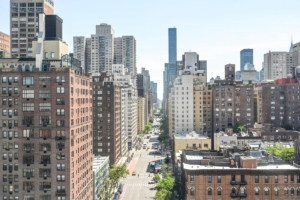Billions of dollars pour into residential real estate in New York City each year, but not all of it comes from New Yorkers purchasing their primary residence. A healthy portion of purchases are made by investors who buy individual units and list them for rent after closing. Condos — many of which are owned by individual investors — made up more than 11 percent of the Manhattan listings on StreetEasy during the first half of 2017.
How the Numbers Work
Investors make money from condos in two ways: rental income generated from tenants, and capital gains generated from appreciation in the resale value of the unit over time. In this analysis, we used our listing data to focus on rental income for Manhattan condos. We looked at more than 8,000 instances of Manhattan condos listed on StreetEasy that sold between January 2010 and June 2017 and then appeared as a rental unit on StreetEasy within 180 days.
To illustrate how this investment process works, take this unit on East 88th Street as an example. This studio apartment was purchased for $690,000 on May 2. After listing the unit for rent for $2,550 per month — and assuming the apartment was rented for that price — the condo owner will collect $1,414 a month after paying common charges of $501 and property taxes of $635. This results in a net income of $16,968 on an annual basis, or 2.5 percent of the total purchase price. This does not account for financing, leasing, or renovation costs, which can accumulate over time.
Key Takeaways:
- Owners of newly purchased Manhattan condos collected 2.5 percent of their purchase price in annual rental income on investments listed on the rental market in Q2 2017, down from a Q3 2011 peak of 3.9 percent.
- More expensive properties yielded lower returns. Units priced under $750,000 yielded a median 3.3 percent return, whereas units priced over $3 million yielded a median 2.6 percent.
- Studio apartments generated higher yields than larger units, earning a median 3.1 percent compared to 2.6 percent and 2.5 percent for 1 and 2-bedroom rentals, respectively.
- Units in Upper Manhattan generated higher income per dollar invested than elsewhere in Manhattan, earning a median 3.5 percent.
Investors Bet on Price Appreciation
Overall, we found that Manhattan condo owners collect a median 2.5 percent annually on investment properties listed for rent in Q2 2017. With the relatively risk-free 10-year Treasury rates yielding more than 2 percent, which is a comparable yield to many of these apartments, investors appear to be speculating on future price and rental growth to turn a profit on their investments.
Higher-Priced Condos Generate Less Income on a Relative Basis
The median rent yield from a Manhattan condo investment has fallen steadily from its peak of 3.9 percent in Q3 2011. This drop corresponds with a steep increase in the median sale price of condo units on the rental market, which nearly doubled from $899,000 to $1.7 million between the 2011 peak in yields and Q2 2017. The median asking rent on these condo units increased 34 percent from $3,950 to $5,275 over the same period.
[tableau server=”public.tableau.com” workbook=”CondoYields” view=”Time” tabs=”no” toolbar=”no” revert=”” refresh=”yes” linktarget=”” width=”690px” height=”625px”][/tableau]The decrease in investor returns and corresponding increase in the sale price of condo units entering the rental market are a result of two factors: sale price growth outpacing the growth of rent prices on similar units, and a shift toward more expensive units entering the rental market. Looking across 2,400 condos on the rental market between 2015 and 2017, we found that more expensive properties had lower yields. Units priced under $750,000 have a median yield of 3.3 percent, whereas units priced over $3 million have a median yield of 2.6 percent.
[tableau server=”public.tableau.com” workbook=”CondoYields” view=”Prices” tabs=”no” toolbar=”no” revert=”” refresh=”yes” linktarget=”” width=”700px” height=”635px”][/tableau]
Studio Apartments Generate More Income Per Dollar Invested
The income generated by condo investments varies widely, but is distributed evenly around the 2.7 percent median over the past two years. More than 80 percent of the rental income returns we observed on condo listings on StreetEasy were between 1.5 percent and 3.5 percent. Studio apartments tend to generate higher yields than larger units at 3.1 percent compared to 2.6 percent and 2.5 percent for 1- and 2-bedroom units, respectively, a trend consistent with lower-priced units yielding more than higher-priced units.
[tableau server=”public.tableau.com” workbook=”CondoYields” view=”Distribution” tabs=”no” toolbar=”no” revert=”” refresh=”yes” linktarget=”” width=”720px” height=”655px”][/tableau]
Upper Manhattan Offers an Attractive Investment Landscape
We typically see fewer condos on the rental market in Upper Manhattan neighborhoods (Washington Heights, Hamilton Heights, Inwood, Marble Hill, Manhattanville, and Harlem), but the ones that do hit the market tend to generate high levels of income on a relative basis. Part of this trend is explained by their lower prices, but as the figure below shows, many of these neighborhoods are still outliers.
[tableau server=”public.tableau.com” workbook=”CondoYields” view=”Neighborhoods” tabs=”no” toolbar=”no” revert=”” refresh=”yes” linktarget=”” width=”720px” height=”655px”][/tableau]
StreetEasy user data confirms that these areas are becoming increasingly popular among residents seeking greater affordability who are also willing to extend their commutes. Many of these neighborhoods are anecdotally cited as among the most rapidly changing neighborhoods in the city, with many speculating that prices will continue to approach levels similar to other areas of Manhattan. Logic would normally dictate that investors expecting higher price appreciation would be willing to accept lower income in the near term. Yet paradoxically, our data shows that units in Upper Manhattan tend to have some of the highest income per dollar invested.
Even with Rental Income, Investors Can Still Lose Money
While we focus here on the income condo owners receive from their investment, owning a condo can entail costs and risks that can diminish profits. The yields in this analysis don’t account for additional costs that condo owners face, including income taxes, financing costs, unit-specific maintenance costs not included in condo fees, and any property management costs, including leasing costs and rent collection. Moreover, renting a condo involves considerable risk and headaches, including troublesome tenants, maintenance requests at odd hours, and substantial legal liabilities.
How We Did It
We focused on more than 8,000 instances of Manhattan condos listed on StreetEasy that closed between January 2010 and June 2017 and then appeared as a rental unit on StreetEasy within 180 days of closing.[1] Limiting the time between purchase and rental allowed us to get a better sense of the true yield of the investment, as units with a short period of time between closing and becoming a rental unit are likely to have fewer improvements not reflected in the price, and less price appreciation in the time between closing and rental posting. In calculating the yield of condo investments, we factored in common charges and property taxes as reported by condo listing agents, as well as the 1 percent sale tax on all units over $1 million.[2] Our yield calculation does not account for financing or closing costs such as mortgage and real estate adjustment taxes or agent and titles insurance fees, which can vary from buyer to buyer and unit to unit. Our analysis also does not include the tax implications of rental income and leasing and property management costs arising from the ongoing ownership of a rental property, which can also vary among units, tenants, and owners.
[1]The majority of condos listed as a rental unit on StreetEasy shortly after closing are in Manhattan. Given this, we focused our analysis solely on Manhattan.
[2]Given that this tax affects all units with closing prices over $1 million equally, we included this closing cost in our analysis. However, our finding that lower-priced units tend to generate higher income per dollar holds true without applying this tax adjustment to closing prices.
—
Hey, why not like StreetEasy on Facebook and follow @streeteasy on Instagram?
Related:










